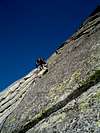|
|
Route |
|---|---|
|
|
38.79940°N / 120.135°W |
|
|
Technical Rock Climb |
|
|
Less than two hours |
|
|
5.5 |
|
|
Overview
This is one of the easiest routes at Lovers Leap. It is an excellent route for newbies to practice leading. It should take about 2-3 hours, depending on experience and party size. The rock quality is excellent.
Approach
The North Face of the Hogsback is the fairly gently-sloping rock face that is closest to Highway 50. From the Lovers Leap campground walk about a third of a mile up the trail. Hogsback will be on the left and the main Lovers Leap walls will be on the right. You should see a notch between Hogsback and a subsidiary rock, and a use trail leading through the notch from the main trail. Take this use trail and follow it all the way around until you are on the Highway 50 side of Hogsback. Knapsack Crack begins by following a crack/right-facing dihedral. It is on the northeast (left) side of Hogsback and ends northeast of the summit of Hogsback. You'll know you are at the base of the route when you see a stout juniper 100 feet above you and a decent-sized patch of scrub about 50 feet up and to the left of the route.
Route Description
Pitch 1: 4th-low 5th class, 100 ft. Climb just to the right of a right-facing dihedral. There are excellent places for protection in the dihedral and in the crack paralleling the dihedral. Pitch 1 ends on a ledge where there is a large tree (good place for an anchor).
Pitch 2: 5.5, ~ 150 ft. Continue following the dihedral/slightly leftward oriented crack system. The route will steepen a bit and enter a fairly wide crack with good holds. Still, there are many places for pro. The short crux is reached where the crack narrows too much to continue inside. At the crux, there is an old but somewhat solid-looking piton to clip into. The piton is inside the crack on the right side. Other pro should be placed there, too. Move out left onto the face, using the now-narrow crack above for jams. Above this short crux section, the climbing becomes easier as it enters a broadening, shallow gully and flattens a bit. Where it flattens, there is a good seat for belaying. Resist the urge to continue climbing, because this is a comfortable spot for a gear anchor.
Pitch 3: class 4, ~100 ft. The climbing continues up the gully until it reaches the fairly flat shoulder of Hogsback.
Two Pitch Variation
It is also possible to complete the route in two pitches instead of three. Set-up the first belay anchor about 20-25 feet above the tree ledge. (Many thanks to Diggler for this adittional beta).
Descent: hike down the shoulder towards the notch then reverse the approach route back to the parking lot.
Essential Gear
Lots of slings and carabineers, a cordelette, a 60-meter rope, cams to two inches, and a set of nuts should get you up there in one piece.





Diggler - Jun 17, 2004 12:10 pm - Hasn't voted
Route CommentHey Dave,
if one goes above the tree ledge by maybe 20-25' (not quite to the end of a 60-m rope from the base), the climb would go at 2 pitches. I heard this from a girl @ the Hogsback & went about 15' past the tree ledge thinking this would suffice (I still had 20 or so ft of rope left, I think). I was really pissed when I got to the absolute end of the rope & only had another 10' or so of climbing left!!